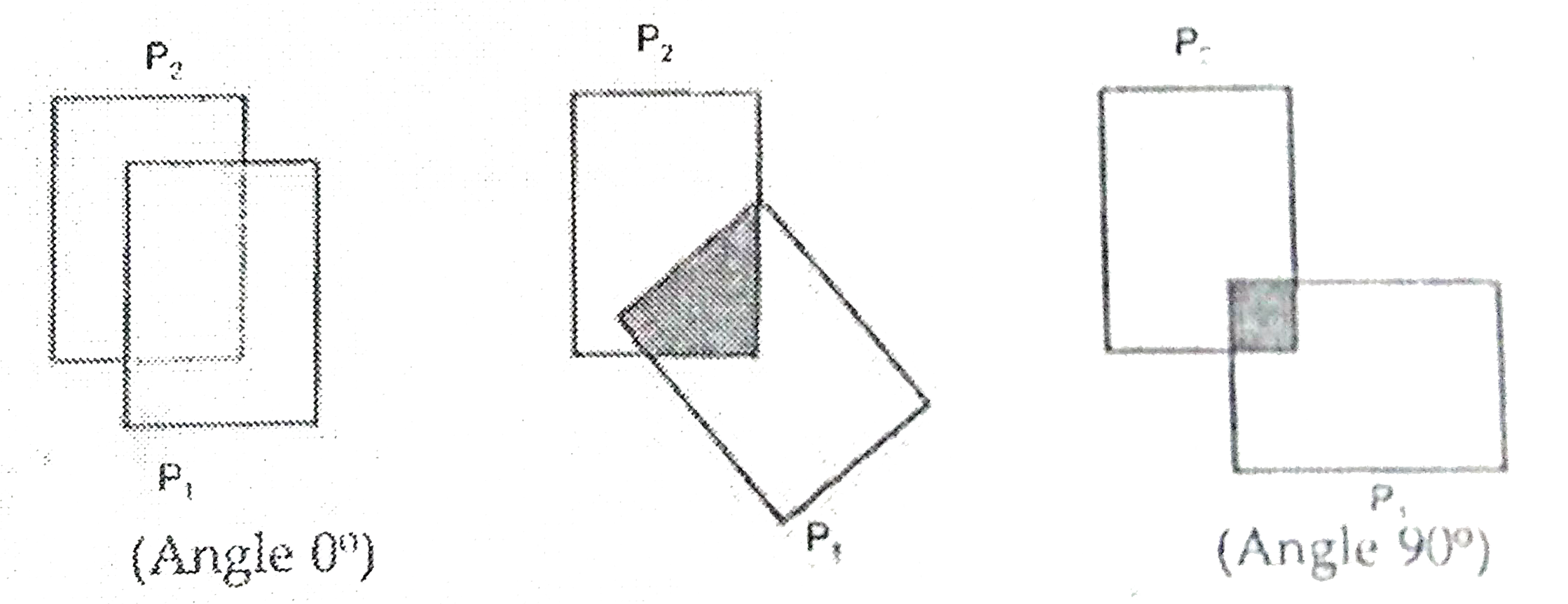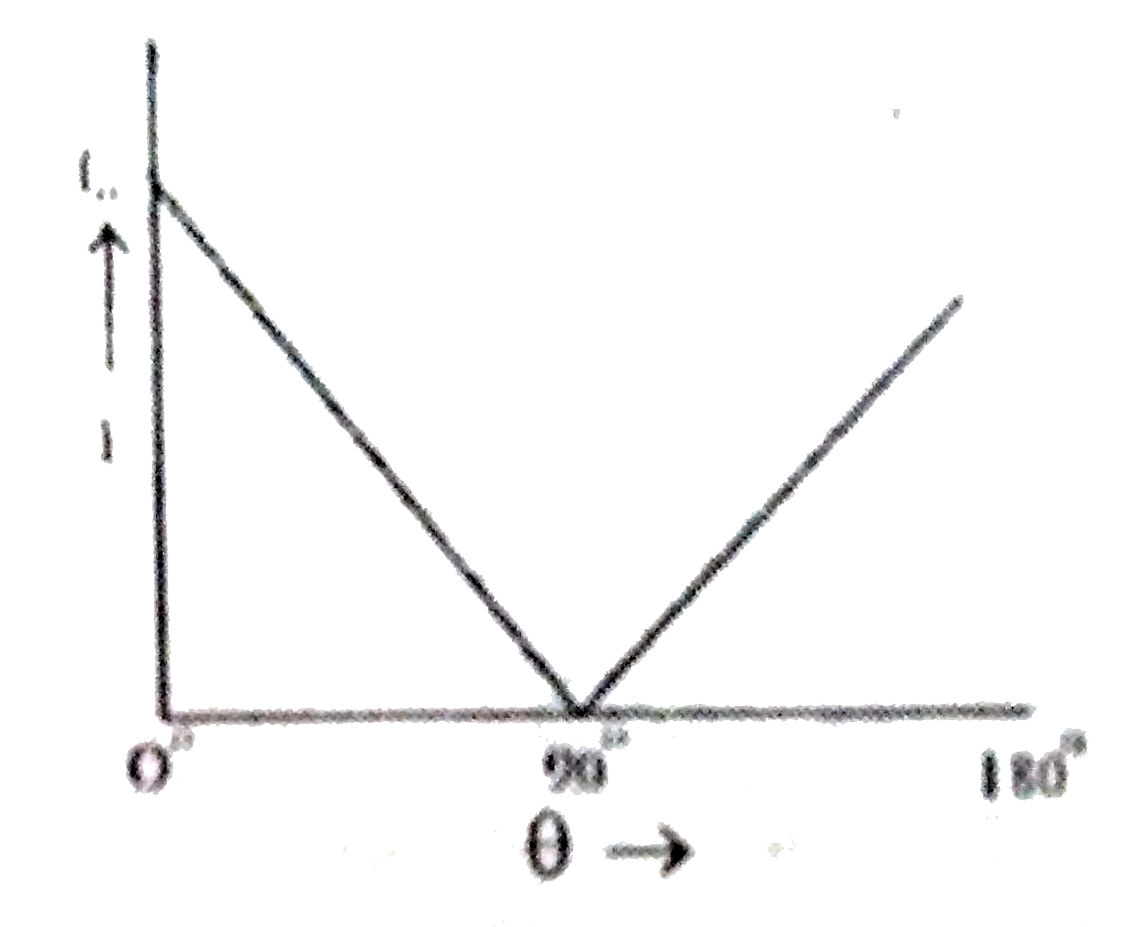How does an unpolarised light get polarised when passed through a polaroid ?
Two polaroids are set in crossed positions . A third polaroid is placed between the two making an angle θ with the pass axis of the first polaroid . Write the expression for the intensity of light transmitted from the second polaroid . In what orientations will the transmitted intensity be (i) minimum and (ii) maximum ?
If an unpolarised light wave is incident on a polaroid then the light get linearly polarised with the electric vector oscillating along a direction perpendicular to the aligned molecules .
If the light from an ordinary source (like a sodium lamp) passes through a polaroid sheet P1, it is observed that its intensity is reduced by half.Rotating P1 has no effect on the transmitted beam and transmitted intensity constant .
Let an identical piece of polaroid P2 be placed before P1 , the light from the lamp is reduced in intensity on passing through P2 alone . But rotating P1 has effect on the light coming from P2.
In one position , the intensity transmitted by P2 followed by P1 is nearly zero . When turned by 90∘ from this position P1 transmits nearly the full intensity emerging from P2 as shown in fig.

Graph : The graph between intensity of light and the angle between polariser and analyser is shown in the figure .
When the polaroid is rotated in the path of plane polarised light , its intensity will vary from maximum (When the vibrations of the plane polarised light are parallel to the axis of the polaroid ) to minimum (When the direction of vibrations becomes perpendicular to the axis of the crystal).
Let I0 be the intensity of polarised light after passing through first polariser P1 . Then intensity of light after passing through second polariser P2 is given by I=I0cos2θ.

Topper's Solved these Questions
- XII BOARDSBook:XII BOARD PREVIOUS YEAR PAPER ENGLISHChapter:XII BOARDSExercise:SET -II
Explore 9 Videos
- XII BOARDSBook:XII BOARD PREVIOUS YEAR PAPER ENGLISHChapter:XII BOARDSExercise:SET -III
Explore 4 Videos
- XII BOARDSBook:XII BOARD PREVIOUS YEAR PAPER ENGLISHChapter:XII BOARDSExercise:SET-III DELHI BOARD
Explore 10 Videos
- SAMPLE PAPER 2019Book:XII BOARD PREVIOUS YEAR PAPER ENGLISHChapter:SAMPLE PAPER 2019Exercise:SECTION D
Explore 6 Videos
Similar Questions
Two polaroid A and B are set in crossed positions. A third polaroid C is placed between the two making ∠θ with the pass axis of first polaroid. Write the expression for intensity of light transmitted from second polaroid. In what orientations will be transmitted intensity be (i) minimum (ii) maximum ?
View SolutionPolaroids are used
View SolutionA plane polarised light is passed through a polaroid, when the polaroid is given one full rotation about the direction of light, then
View SolutionUnpolarised light of intensity I is passed through a polaroid. What is the intensity of emerging polaroised light ?
View SolutionState one use of a Polaroid.
View SolutionTwo 'crossed' polaroids A and B are placed in the path of a light-beam. In between these, a third polaroid is C is placed whose polarisation axis makes an angle θ with a polarisation axis of the polaroid A. If the intensity of light emerging from the polaroid a is Io then the intensity of light emerging from polaroid B will be
View SolutionTwo polaroids are placed in the path of unpolarized beam of intensity I0 such that no light is emitted from the second polarid. If a third polaroid whose polarization axis makes an angle θ with the polarization axis of first polaroid, is placed between these two polariods then the intensity of light emerging from the last polaroid will be
View SolutionPlane polarised light is passed through a polaroid. On viewing through the polaroid we find that when the polaroid is given one complete rotation about the direction of light
View SolutionAn unpolarized light with intensity 2I0 is passed through a polaroid. The resultant intensity of the transmitted light will be
View SolutionUnpolarised light is passed through a polaroid P1. When this poalrised beam passes through another polaroid P2, and if the pass axis of P2 makes an angle θ with pass axis of P1, then write the expression for the polarised beam passing through P2. Draw a plot showing the variation of intensity when θ varies from 0 to 2 π.
View Solution